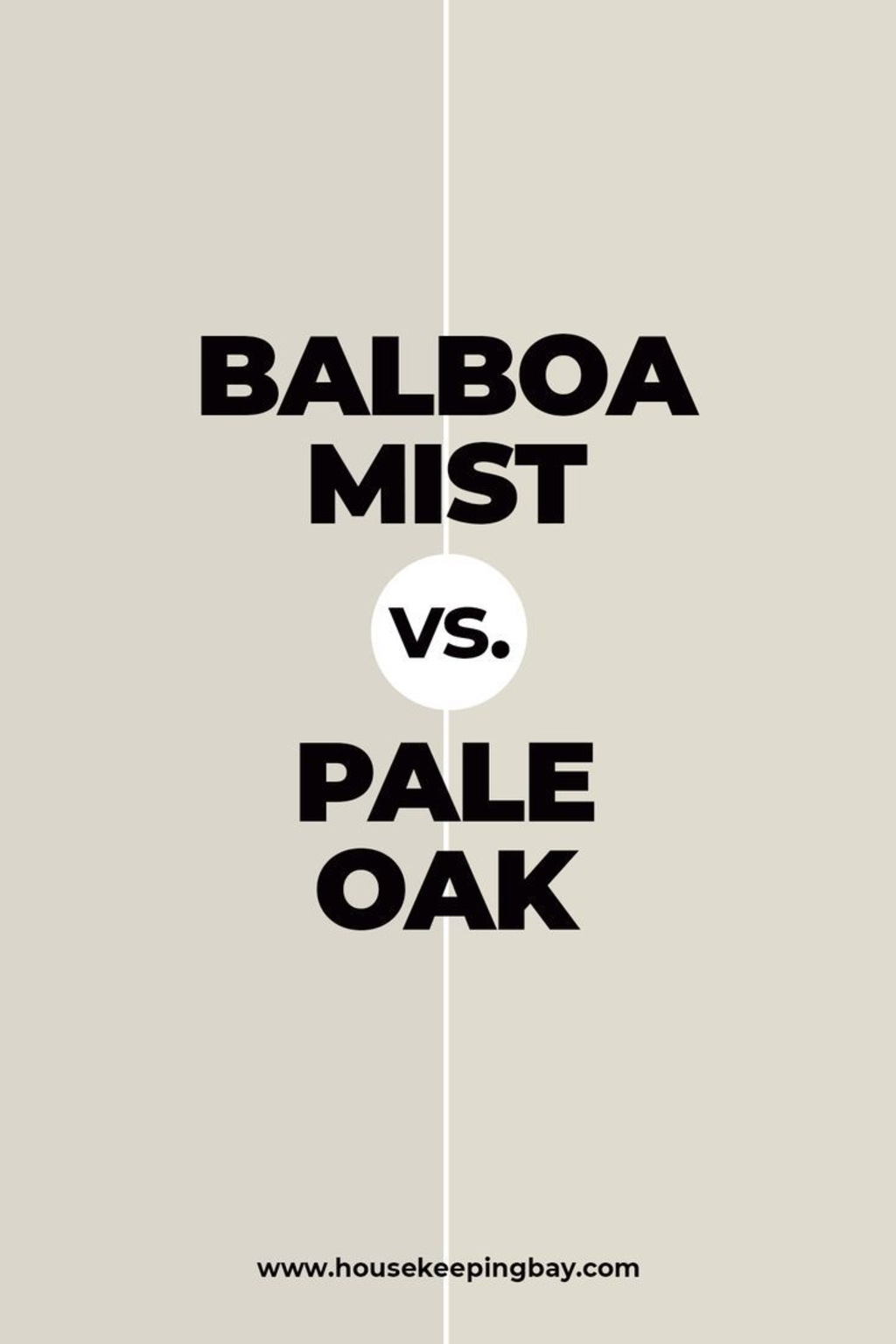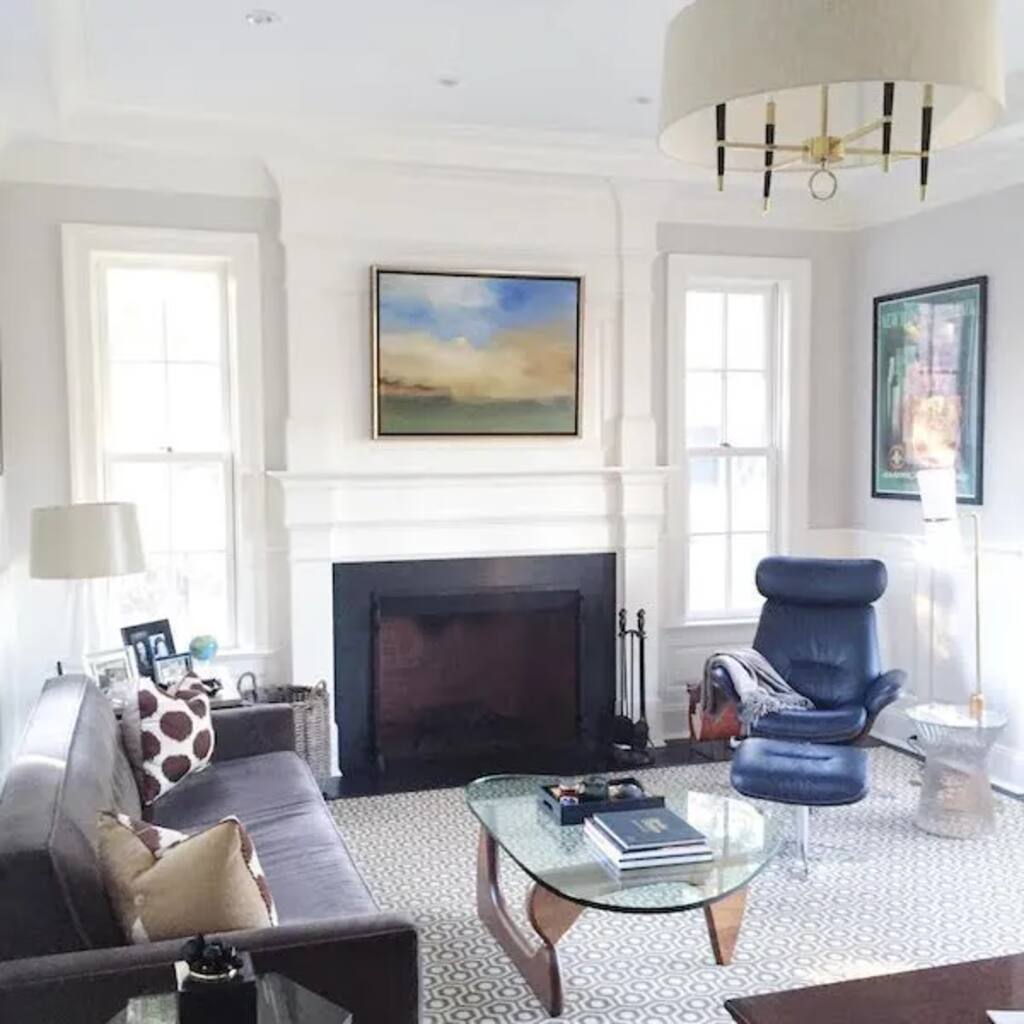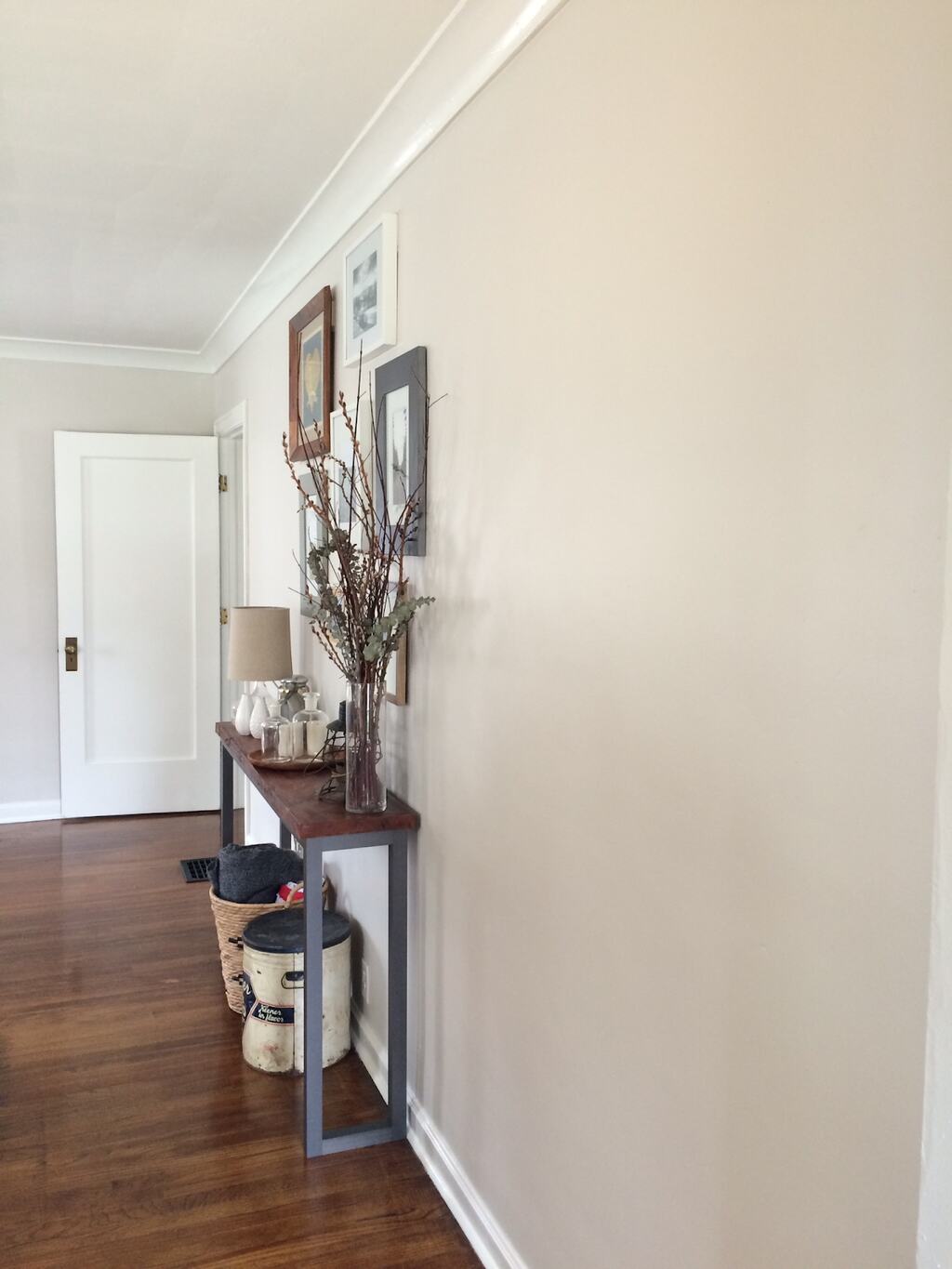In this blog, I’ll compare two similar colors by Benjamin Moore: Balboa Mist vs Pale Oak.
Have you ever found yourself staring at paint swatches, completely torn between two almost identical colors? While they may look similar at first glance, Balboa Mist and Pale Oak have distinct differences in undertones, lighting effects, and overall feel.
I’ll break down their undertones, lighting effects, and best uses so you can confidently choose the perfect shade for your space. Let’s get started.
What color is Balboa Mist?
Balboa Mist (OC-27) by Benjamin Moore is a light, warm greige that strikes the perfect balance between gray and beige.
It’s soft, airy, and versatile, making it a go-to neutral for many homeowners.
While it’s technically part of Benjamin Moore’s Off-White Collection, it has just enough depth to stand out against bright white trim without feeling too stark.
This color is a true chameleon, meaning it can shift slightly depending on the surrounding elements and lighting.
In some spaces, it leans more gray, while in others, it pulls warmer. This versatility makes it a great option for living rooms, bedrooms, kitchens, and open-concept areas where you want a soft, inviting feel.
What is Pale Oak?
Pale Oak (OC-20) by Benjamin Moore is a soft, warm greige with a sophisticated and airy feel.
It sits right between beige and gray, making it an excellent neutral choice for those who want a subtle warmth without an overpowering yellow undertone.
Part of Benjamin Moore’s Off-White Collection, Pale Oak is light and refined, offering a delicate balance between cozy and modern.
Because of its adaptable nature, Pale Oak is perfect for living rooms, bedrooms, and kitchens, especially in homes that embrace a warm and neutral color palette.
It’s a fantastic choice if you want a paint color that’s light, warm, and effortlessly timeless.
Comparing Balboa Mist and Pale Oak

While both Balboa Mist and Pale Oak are soft, warm greiges, Balboa Mist leans slightly cooler with a touch of violet undertones, whereas Pale Oak has a warmer, more beige-like appearance with subtle pink or taupe undertones. Let’s compare these two colors:
Comparing LRVs
When comparing the Light Reflectance Value (LRV) of these two colors, Pale Oak (LRV 69) is slightly lighter than Balboa Mist (LRV 65).
This means Pale Oak reflects more light and can make a room feel a bit brighter and airier, while Balboa Mist has a touch more depth, offering a slightly cozier feel.
The direction your room faces can also influence how these colors appear. In north-facing rooms, where the light is cooler and slightly grayish, Balboa Mist may lean a bit more gray, while Pale Oak might reveal its subtle pink or taupe undertones.
In south-facing rooms, where the light is warm and abundant, both colors will appear softer and warmer, but Pale Oak may lean more beige, whereas Balboa Mist maintains a balanced greige tone.
If you want a brighter, more open feel, Pale Oak may be the better choice, while Balboa Mist works well for a slightly moodier, more grounded aesthetic.
Comparing undertones
When it comes to undertones, Balboa Mist and Pale Oak may both be considered greiges, but they have subtle differences that can impact how they appear in your space.
Balboa Mist leans slightly cooler with soft violet or taupe undertones. This means it can sometimes read more gray in cooler lighting, but the taupe influence keeps it from feeling too cold.
Pale Oak, on the other hand, has warmer undertones with a hint of pink or taupe. In certain lighting, especially in low-light spaces, those pinkish undertones can become more noticeable, giving it a soft, almost rosy warmth.
If you prefer a crisper, slightly cooler greige, Balboa Mist is the better choice. But if you want something that feels a bit warmer and cozier, Pale Oak might be the way to go. Your lighting and surrounding décor will ultimately determine how these undertones show up in your space.
Comparing RGB
When comparing the RGB values of Balboa Mist and Pale Oak, you can see how their subtle differences in color composition influence their overall look.
- Balboa Mist (OC-27): RGB: 218, 213, 204
- Pale Oak (OC-20): RGB: 222, 216, 205
At first glance, the numbers are quite close, but there are key differences. Balboa Mist has slightly less red (218 vs. 222) and green (213 vs. 216), making it appear a touch cooler.
Its lower blue value (204) helps maintain a soft greige balance without veering too cool.
In practical terms, Balboa Mist can look a bit more refined and neutral, whereas Pale Oak has a softer, warmer feel.
If you’re trying to decide between the two, considering the lighting in your space will help determine which undertones and warmth levels work best!
Comparing VOC
When comparing the VOC (Volatile Organic Compound) levels of Balboa Mist and Pale Oak, both colors are available in Benjamin Moore’s Natura line, which is known for being an eco-friendly choice with zero VOC content.
However, since both Balboa Mist and Pale Oak come in the Natura line, they don’t contain any harmful VOCs, ensuring a healthier and more sustainable painting experience.
So, whether you choose Balboa Mist or Pale Oak, you can feel confident that both options offer a low-impact, low-odor solution without compromising on the quality or finish of the paint.
If you’re sensitive to smells or looking for an eco-conscious option, both are excellent, VOC-free choices.
Balboa Mist Coordinating Colors:
- Simply White (OC-117): A crisp, clean white that complements Balboa Mist’s soft neutrality.
- Hollingsworth Green (HC-141): A muted green that adds a natural touch without overpowering Balboa Mist.
- Wythe Blue (HC-143): A soft blue that pairs well with the cool undertones of Balboa Mist.
- Stonington Gray (HC-170): A refined gray that enhances the understated elegance of Balboa Mist.
Pale Oak Coordinating Colors:
- Simply White (OC-117): A bright white that highlights Pale Oak’s warmth and elegance.
- Heathered Pearl (2117-60): A soft, warm taupe that enhances the pinkish undertones in Pale Oak.
- Pineapple (2134-40): A fresh green that brings out Pale Oak’s subtle warmth.
- Hale Navy (HC-154): A deep navy that contrasts beautifully with the light warmth of Pale Oak.
How to choose the Right Color?

If you’re stuck between Balboa Mist and Pale Oak, I get the struggle! I’ve been there, trying to figure out which one would work best in my space.
Let me break it down for you, so you don’t have to spend as much time going back and forth between the two.
First, if you’re after a cooler, more neutral vibe, Balboa Mist could be your go-to.
I’ve used it in a few rooms with good natural light, and it brings a sense of openness and serenity.
It pairs beautifully with cooler tones like blues or grays and looks great in living rooms or entryways that get plenty of sunlight.
Now, if you’re leaning toward something that feels warm and inviting, Pale Oak is a fantastic option.
I’ve found that Pale Oak works especially well in bedrooms, kitchens, or any space where you want a relaxed, welcoming vibe.
If your room doesn’t get as much natural light, this color helps balance things out and creates a warm, soft environment.
It pairs nicely with wood tones, earthy neutrals, or even a pop of greenery, making it feel grounded and comfortable.
At the end of the day, it depends on the vibe you want to create in your space. Trust me, you can’t go wrong with either—it’s all about what fits your style and space best.

Conclusion
Choosing between Balboa Mist and Pale Oak ultimately comes down to the mood you want to set in your space. If you lean towards a cooler, more neutral aesthetic, Balboa Mist will bring a sophisticated, airy feel with its soft gray undertones. It’s perfect for rooms where you want a bit of serenity and openness, especially with lots of natural light.
Both colors have their unique qualities, so it boils down to the lighting in your room, the mood you want to create, and your style. Whether you choose Balboa Mist for its refined coolness or Pale Oak for its soft warmth, rest assured that either color will elevate your home with its timeless elegance. Happy painting.
FAQs
Which color works better in low-light rooms?
Pale Oak shines in dim spaces, with its warm undertones adding coziness, while Balboa Mist can appear cooler and softer.
Do these colors work well with white trim?
Both Balboa Mist and Pale Oak complement the white trim perfectly, offering a subtle contrast that’s never too stark.
Which color is more versatile for different spaces?
Balboa Mist is incredibly versatile, fitting well in almost any room, while Pale Oak excels in creating a welcoming, warm vibe for living rooms and bedrooms.
How do these colors fare with wood tones?
Pale Oak pairs wonderfully with natural wood tones, while Balboa Mist complements cooler-toned woods and metallic accents.
How do these colors fare with wood tones?
Pale Oak pairs wonderfully with natural wood tones, while Balboa Mist complements cooler-toned woods and metallic accents.
Can these colors be used in small rooms?
Both are excellent choices for small rooms, with Balboa Mist making a space feel more open and Pale Oak providing a soft, cozy atmosphere.

